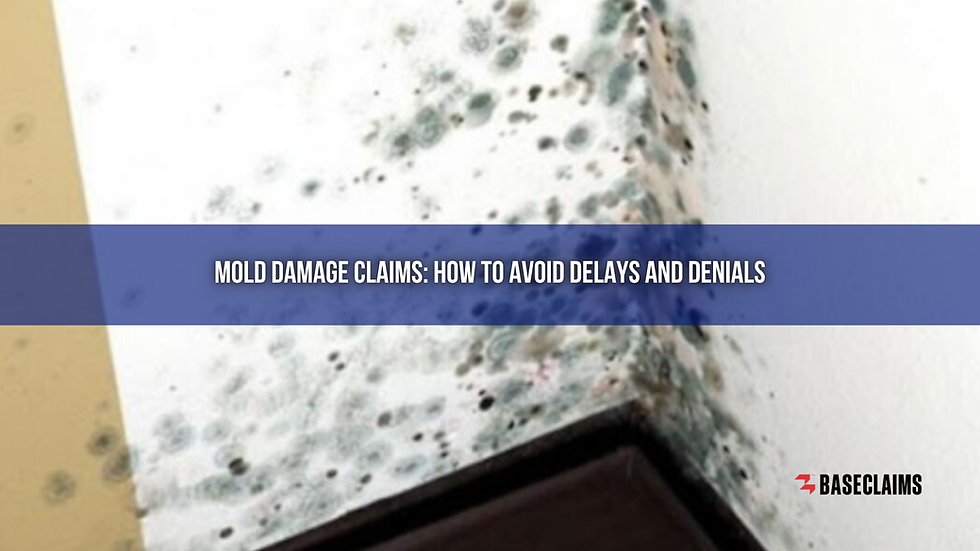What Homeowners Miss in Water Damage Claims: Hidden Moisture and Mold Risks
- Benji Licht
- May 13, 2025
- 3 min read
Updated: May 28, 2025
🕵️ Hidden Moisture Risks in Water Damage Claims
Experiencing water damage can be devastating not just because of the visible destruction, but because of what often remains unnoticed: trapped moisture beneath surfaces and the mold that silently follows. Many homeowners, in the rush to restore their property, unknowingly overlook these hidden threats. This oversight doesn’t just affect the safety of your living space — it can severely impact your water damage claim as well.
💨 Why Surface Drying Isn’t Enough
After a flood or pipe burst, drying the area with fans or dehumidifiers might seem sufficient. But moisture has a sneaky way of settling behind walls, under floors, or inside insulation. These areas are rarely inspected properly without specialized tools, making it easy for water to linger unnoticed.
Trapped dampness may not trigger immediate signs, but over time, it creates the perfect conditions for microbial growth. The longer it remains undetected, the higher the chances of structural weakening, warped materials, and severe air quality issues.
🦠 Mold Risk: The Hidden Health Hazard
Even small amounts of hidden moisture can lead to mold growth. And while a musty smell or discolored patch might eventually alert you, mold is often well established before it becomes visible.
Mold isn’t just an aesthetic problem; it poses serious health risks, especially for people with allergies, asthma, or weakened immune systems. Prolonged exposure can lead to respiratory issues, headaches, and chronic sinus infections. Worse yet, some types of mold release toxins that can affect cognitive function.
This is why addressing potential mold risk after water damage should be a top priority — not an afterthought.

⚠️ The Consequences of Overlooked Damage on Insurance Claims
Many homeowners assume their water damage claim covers everything visible and invisible. Unfortunately, insurance adjusters often focus only on the apparent damage unless you provide clear evidence of deeper issues.
When hidden moisture is missed during the initial inspection, your claim might be underpaid or outright denied for later mold problems. Most policies have specific conditions about how soon mold must be reported. If it surfaces after the initial claim, insurers may argue that the damage resulted from neglect, not the original incident.
This is where early detection becomes not just smart — but essential.
🔍 The Role of Specialized Inspections in Uncovering Hidden Issues
A thorough post-damage inspection requires more than a flashlight and clipboard. Moisture meters, thermal imaging, and humidity sensors allow professionals to identify trapped water pockets that could go unnoticed by the untrained eye.
That’s where Base Claims inspection makes a measurable difference. Their team uses advanced diagnostic tools and deep industry knowledge to pinpoint risks before they escalate — making sure nothing is overlooked in your documentation. This meticulous approach can strengthen your insurance claim and reduce the risk of future disputes.
🛠️ How to Strengthen Your Claim from the Start
Navigating a water-related incident is stressful, but taking the right steps early on can save you time, money, and future frustration. Here are proactive actions every homeowner should consider:
Document Everything Photograph all affected areas, even those that don’t appear damaged. Moisture often spreads beyond what’s visible.
Request a Full Moisture Assessment Don’t settle for a quick visual check. Demand a full diagnostic evaluation, especially behind walls, under tiles, and in ceilings.
Keep a Restoration Timeline Log every cleanup or restoration step you take. Insurers appreciate detailed records.
Involve an Independent Adjuster if Necessary If you feel your insurer isn’t addressing all the damage, consult a licensed claims advocate. They work in your interest, not the insurer’s.
⏳ Hidden Humidity Today, Bigger Problems Tomorrow
What’s invisible today could become unmanageable tomorrow. Structural weakening, mold colonies, and ongoing humidity issues can lower your property’s value and make future insurance negotiations harder.
By recognizing the importance of a detailed inspection you protect your investment, your health, and your right to fair compensation.
The goal isn’t just recovery; it’s making sure no lingering damage is left behind.
Benjamin Licht 954-589-8710
Office 954-466-5730
Don’t wait until it’s too late






Comments